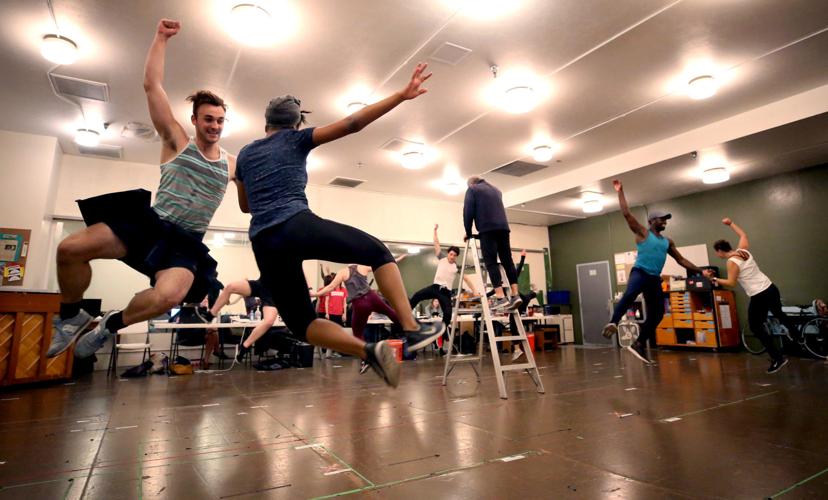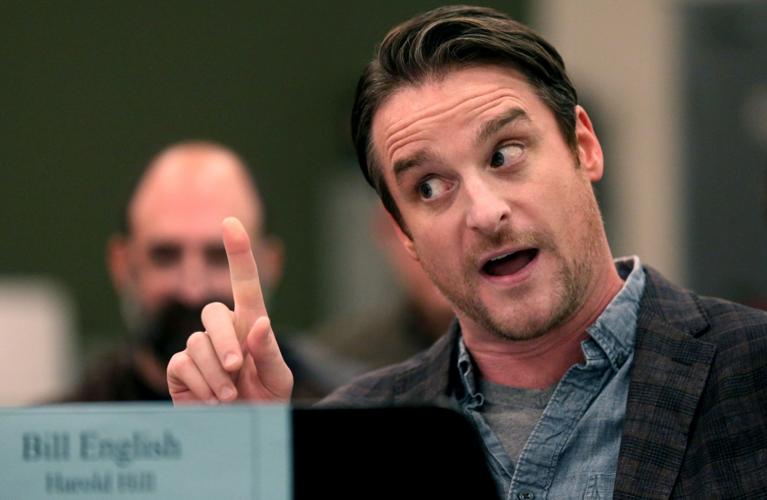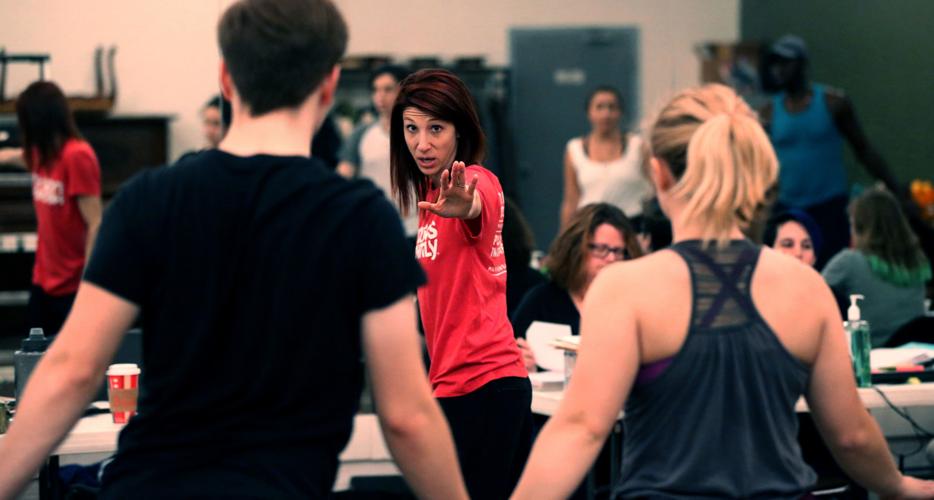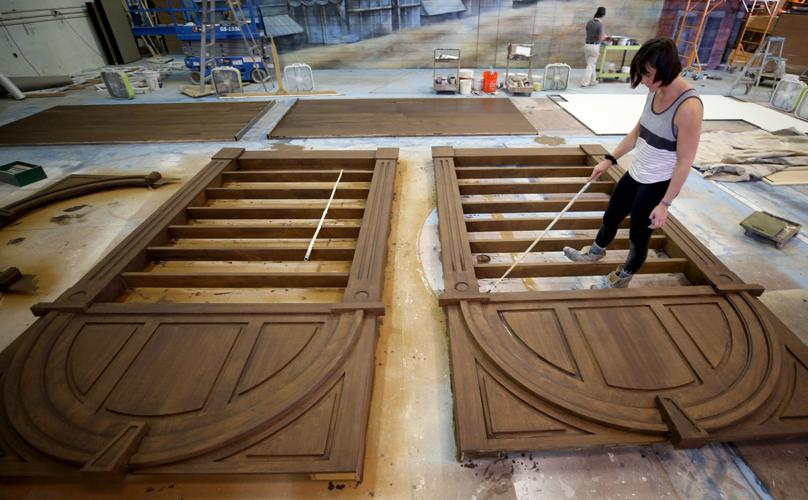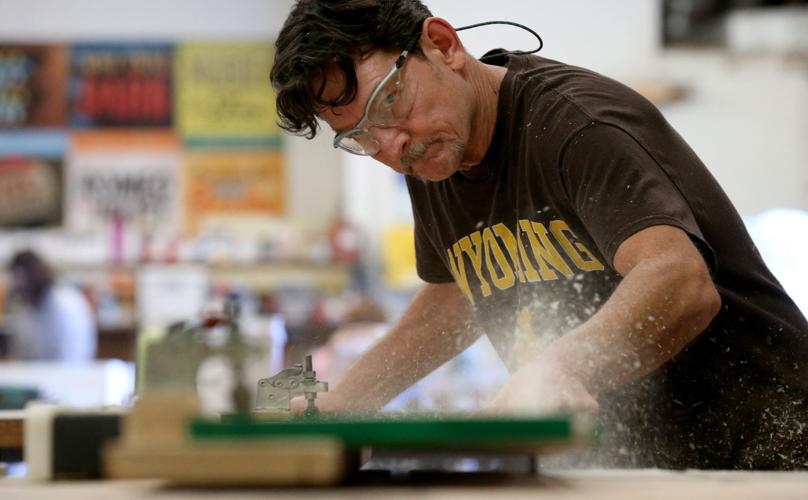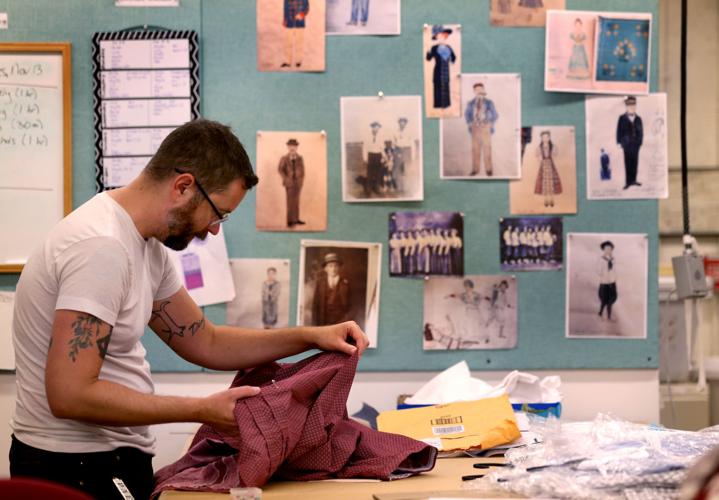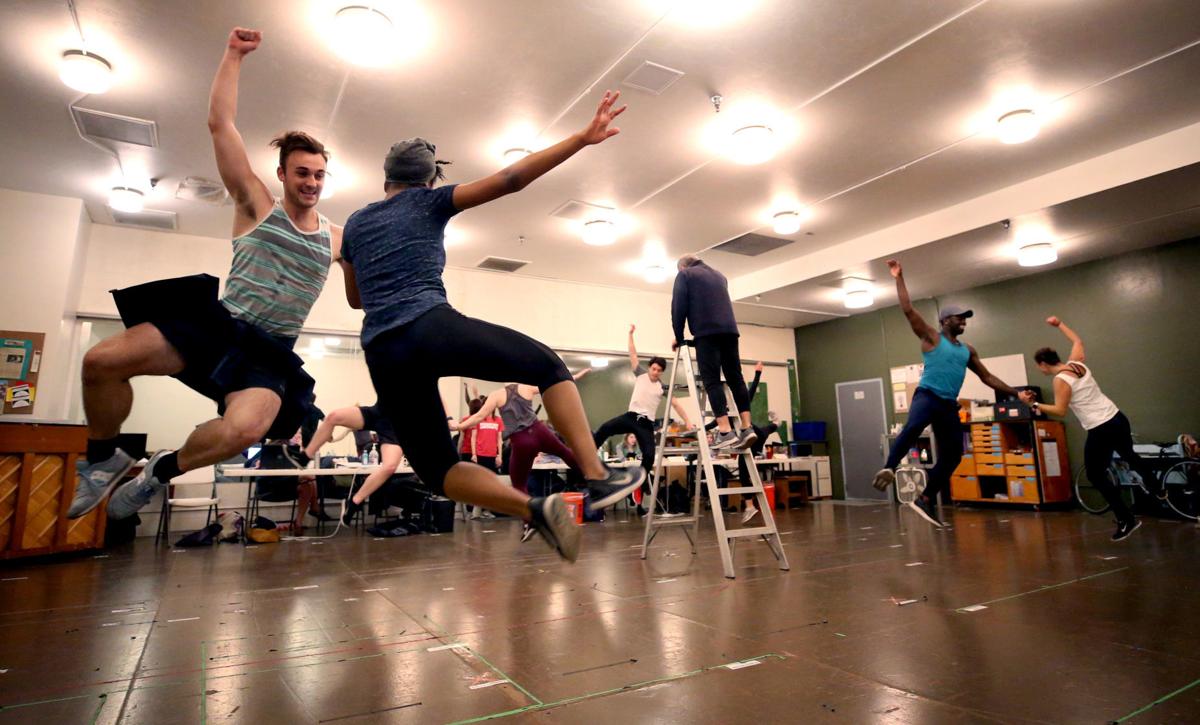Arizona Theatre Company is headed for River City, Iowa.
The stage at the Temple of Music and Art will be transformed into that fictional town in the year 1912 for the giddy Meredith Willson musical “The Music Man,” about a flimflam man who jumps off a train in River City and promises a boys band for the price of uniforms and instruments. He has no intention of fulfilling that promise.
It opens in previews Dec. 1. When audiences sit down, it will look like the journey to get there was effortless.
But it’s been a long, hard and creative trip.
Here’s a behind-the-scenes look at what it takes to stage the massive musical.

Director David Ivers watches the cast go through a sing-in for the early days of the Arizona Theater Company’s production of “The Music Man,” on Wednesday, Oct. 31.
LAYING THE GROUNDWORK
David Ivers, ATC’s artistic director, initially didn’t intend to direct this production. But when the person he wanted wasn’t available, he took it as a sign he should.
And he jumped in with abandon.
“I’m such a sucker for joy and empathy and romance and winning the day,” says Ivers. “I just think it’s a perfect musical. I always have.”
So the planning began.
ATC’s Arizona Artist Initiative is the company’s commitment to bring as many people with Arizona ties as possible into the theater’s fold. Ivers kept that in mind when he hired key design people, who began work on the play months ahead of rehearsals.
Philip Rosenberg is a Tucson native, a graduate of the University of Arizona and has deep ties to the theater (his late father, George Rosenberg, was a champion of ATC — the annual Georgy award for supporters of the theater is named after him). But with Broadway credits such as “The Elephant Man,” and “A Gentleman’s Guide to Love and Murder,” the New York City-based lighting designer is in demand.
He answered the call and is behind introducing scenic designer Scott Pask to ATC.

Scenic artist Michaela Dannenbrink uses bamboo extensions for her brushes as she adds depth and texture to the paintwork on bookshelves that will be in the River City Library.
Snagging Pask is quite a coup: Also a graduate of the UA, he has won Tonys for his set designs for “The Book of Mormon,” “The Coast of Utopia” and “The Pillowman.” Though based in New York City, he has a home in Tucson that he comes to as often as possible. “Tucson is my escape,” he explains in a phone interview.
Last year, Pask says, Rosenberg rang him up and encouraged him to meet Ivers and see an ATC show.
During the holidays, Pask invited Ivers to his Tucson home. And he was impressed.
“He’s an incredible guy with great energy and ideas,” Pask says. “I’m always inspired by passion.”
Still, he was a tad nervous about saying yes to “The Music Man.” He is a busy man and has to be careful about taking on too much. Plus, he is used to big theaters and big budgets.
“It took some convincing, I’m not going to lie,” he says. “But the more time I spent with David, the more excited I got.”

Property master Paul Lucas rips lumber to build tables that can be both stationary and extend wheels to become mobile for a dance, part of the work in the Arizona Community Theater’s scene shop for their upcoming production of “The Music Man,” on Friday, Nov. 16.
He and Ivers began to plan.
“Scott and I weren’t interested in the Norman Rockwell city,” says Ivers. “We wanted a working city. And it has to hold a million locations.”
Pask dove into research. Old postcards, tintypes, and American Gothic style all inspired his design.
Among the goals: to create a set that could hold at least 10 different locations, speak to the era and the Midwest and inform the actors’ work.
Another goal: “Let’s make it fun and tell the story the best we can.”
Ivers tapped another Tucsonan for the sound design: Abe Jacob.
Here’s the deal: If you notice the sound, the sound designer hasn’t done his job.
“The basic requirement is we need to be invisible,” says Jacob.
There are few that are better at becoming invisible than Jacob.
The Tucson native (and he has retired here) is called “the Godfather of Sound” by those in the theater because he developed modern-day sound design.
He has worked with legends in the music and theater industry. Among his plays: the original Broadway productions of “Jesus Christ Superstar,” “Pippin” and “A Chorus Line.”
Among the rockers he has done sound for: Jimi Hendrix, the Mamas and the Papas, and the Beatles — he did the Fab Four’s last touring concert.
Sound is not just getting the right mic level. There are sound effects that will take us from a train to a pool hall to a scene on a bridge over a river.
And the job isn’t done once the sound is set.
He has to make adjustments, for instance, if audience members are wearing coats, which can absorb the sound. If an understudy has to step in for an actor, that’s another adjustment.
“The Music Man” presents another hurdle.
“It’s a large cast and everyone has to wear (wireless) mics,” he said. “That becomes a financial and technical challenge.”

With dozens of photos and design sketches for reference, stitcher Paul Elliott works on a costume skirt.
Then there are the costumes.
Costume designer Margaret Neville is based in Northern California and has worked around the country, including a number of times with Ivers. The two planned long before rehearsals started, as well. Because so many others have done the musical over the years, ATC was able to get the band uniforms from another theater.
But those have to be adjusted, and the period costumes for 30 cast members had to be constructed, which kept the costume shop in a frenzy during rehearsals.

Choreographer Jaclyn Miller does some fine-tuning in rehearsal for the play’s big dance number, “Shipoopi.” “The Music Man” runs through Dec. 30 at the Temple of Music and Art.
The choreography is in the hands of Jaclyn Miller, who listened to the music over and over before she came to rehearsals to set the dances on the cast.
“The music is telling you the combinations,” she says during a break in a rehearsal. But dance is rarely set in cement before rehearsal. “I have to see who the people are, the abilities I can tap into.”
Music director Greg Coffin knows the music intimately by the time he comes to rehearsals.
REHEARSALS
It’s the first week of rehearsals, and each cast member sits behind a music stand holding the score and his or her’s name in big letters. They have been working on the songs for two days. On this, the third, they will be doing a sing-through of all the songs in the musical.
There’s a cacophony in the room until music director Coffin stands. Everyone quiets down, pianist Michael Padilla does the opening notes of the play’s first song and the singing begins, heads bobbing and pages turning in unison.
After each, Coffin gives notes. “Start low and build” he says about one song. Pencils come out and the actors write down what he says.
He directs when to hold a note, when to cut it quickly.
After an hour, the cast has sung the whole score. They are pumped.
The next day, the actors gather in a semicircle, still with their music stands and name tags. Ivers pulls up a chair in front of them and talks about various elements of the play.

During the first week of rehearsals, Peggy O’Connell as Mrs. Paroo cracks up at the end of one of her numbers during a sing-through of all the songs in “The Music Man.”
He explains the set (“there’s a cinematic quality in how the scene shifts happen”), the costume design (“all costumes are borrowed from American clothing designs”), and the number of weeks the story covers (four). “That’s important to know to keep the authenticity,” he says. “It’s summer and it’s joyful. It’s about 7:30 in the morning when the train comes in.”
The second week of rehearsals start with 60 of the 116-page script worked out. “I like to slap it down and then clean and tweak,” Ivers explains.
The rehearsal hall in the Temple of Music of Art is a fraction the size of the stage. The floor is taped off indicating where the train window will be, the library, the front porch of a home. By the time they get to the theater and on the set, they will know where everything is.
On this day, actors are holding scripts, but rarely refer to them.
Ivers doesn’t believe in being a dictator. While he knows what he wants, he wants to make sure actors are comfortable.
“I have ideas, obviously, but we’ll discover it together,” he says. “If something doesn’t feel right, tell me.”
Bill English, who plays Harold Hill, is working on a scene. He does it three times, with Ivers making adjustments after each, sometimes from his chair, sometimes walking over to English, speaking quietly. The fourth time, he does a tender, heartfelt line delivery. “Great. Beautiful. I love it,” Ivers says.
Characters’ motivations are discussed and actors are directed to move to one place on the stage, and then another, adjust a line delivery, turn a certain way, until Ivers’ image for the scene is solidified.
By the third week of rehearsal, no one is carrying a script.
The first day of this week the choreographer, Miller, will set the big dance number, “Shipoopi.”
She never takes her eyes off the dancers, quickly looking from one to the other. She counts as they move. When she wants to make a change, she glides across the floor, working out the moves in her head and with her body, before she gives instructions.
The dancers appear lighter than air and have a remarkable ability to set a move to memory after seeing it just once.
There’s lots of sweat. And lots of laughter, too.
By the fourth week of rehearsals — two weeks before previews begin — both acts of the play are set. Now Ivers does his tweaking. He’s looking for nuance, precision and he wants his actors to wiggle into the skins of their characters.
He does this by running fragments of scenes over and over, adjusting tiny details. You can see the scene shift, the actors’ intents intensify, the residents of River City come alive. Finally, he says “That’s it. Wonderful.”The actors look relieved. And happy.
THE CAST
Ivers cast a wide net and pulled in Broadway veterans, prize-winning actors, and plenty of Arizona talent — 16 of the 30 cast members have ties to the state — for the musical.
One of those is 9-year-old Nate Wiley, a fourth-grader at Catalina Foothill’s Manzanita Elementary School. He is playing Winthrop, the lisping little boy who is too shy to speak until Harold Hill pulls him out of his shell.

Nate Wiley, who plays Winthrop in “The Music Man,” gets fitted for a River City marching band uniform at Arizona Theatre Company in the Temple of Music and Arts, Tucson, on Nov. 10, 2018.
He is making his professional stage debut with a musical he adores.
Earlier this year, before he even knew ATC was going to mount the musical, he and his family watched “The Music Man” movie. He was hooked. After that he would listen to the music every day, he says. “By the time I auditioned I knew the songs.”
When a reporter pleads for a verse of “Wells Fargo Wagon,” he asks: “Do you want me do all the parts or just mine?”
Nate has taken acting classes at Childsplay in Phoenix, and the Live Theatre Workshop here.
But this experience is different.
For one, he will be doing eight shows a week in Tucson through Dec. 30 and Jan. 5-27 in Phoenix. While the show is on, he will be homeschooled by grandparents both here and while the musical is in Phoenix. That’s a bit hard because he’ll miss his friends at school he says. But he’s curious about what kind of teachers his grandparents, all retired educators, will be.
When he isn’t being schooled — and sometimes when he is — Nate has the play on his mind.
“In my mind, I’m always thinking about Winthrop,” he said. “I’m loving the life of Winthrop — and the life of myself.”
Like Nate, Bill English has loved the musical much of his life.
“I used to listen to the album in my grandparent’s basement,” says English, who is tackling the daunting role of Harold Hill.
Daunting because he is on stage almost every minute. And because Robert Preston, who did the original Broadway production and the 1962 film of the musical, completely possessed the character.
There will be no imitations in his performance, though, he says, “every good actor steals here and there.”
And it is clear in rehearsals that he has made Harold Hill his own but has given him what made Preston so good: a charm that starts out oily but ends up real, and a deep-rootedness in the character.
And English practically crows about the script. “It starts and finishes with Meredith Willson’s genius,” he says. “He marries text and music. … he is like Shakespeare. Every word in there has a purpose. That’s a gift.”

Bill English, as Harold Hill, sings “(Ya Got) Trouble” during the early days of the cast’s preparation for “The Music Man.”
Still, this piece is a challenge.
Harold Hill “never stops,” he says. “Once he sets his plan in motion, it’s like dropping from the top of a roller coaster.”
A few weeks into rehearsal, English turns Harold Hill’s charm into overdrive for the wordy song “(Ya Got) Trouble.” It’s in this scene that the conman fabricates a problem for the community and whips everyone into a musical instrument-and-band-uniform buying frenzy.
The words come quickly, the energy is high, and English-as-Hill seems to cover every inch of the rehearsal room floor.
And he nails it. He has to — this song sets up the whole con.
“‘Trouble’ is the hardest song,” he says. “Harold is a guy who uses his words to overwhelm people, to get them wrapped up in a tornado of words. He delivers with such passion that people can’t help but get caught up. At first, I was intimidated — how can I physically get all the words out of my mouth? At this point, it’s a joy. Now I don’t think about the words, it’s about telling the story.”
Photos: The making of The Music Man at Arizona Theatre Company
The Music Man
Updated
Manna Nichols, in the role of Marian Paroo, gets an ovation after a solo as the cast goes through a sing-in for the early days of the Arizona Theatre Company's production of The Music Man.
The Music Man
Updated
Overhire carpenter Mary Ray grinds down the rough edges on a weld forming the frame on a piece of the Paroo house, part of the work in the Arizona Theatre Company's scene shop for their upcoming production of The Music Man.
The Music Man
Updated
Director David Ivers watches his the cast go through a sing-in for the early days of the Arizona Theatre Company's production of The Music Man.
The Music Man
Updated
EJ Dohring, left, and Adia Bell kick up their heels while the troupe works on the choreography for the number "Shipoopi" as the Arizona Theatre Company gets ready for the opening of their production of The Music Man.
The Music Man
Updated
The cast of The Music Man at Arizona Theatre Company in Tucson.
The Music Man
Updated
Music director Gregg Coffin works with the cast as they go through a sing-in for the early days of the Arizona Theatre Company's production of The Music Man.
The Music Man
Updated
Damon Martinez reads along as others in the cast sing their parts during the early days of the Arizona Theatre Company's production of The Music Man.
The Music Man
Updated
Music director Gregg Coffin asks for a specific adjustment from the cast of the Arizona Theatre Company's production of The Music Man.
The Music Man
Updated
Nate Wiley, who plays "Winthrop" in The Music Man, gets fitted for a River City marching band uniform at Arizona Theatre Company in the Temple of Music and Arts, Tucson.
The Music Man
Updated
Manna Nichols, Peggy O’Connell, and Artistic Director David Ivers in rehearsal for Arizona Theatre Company’s The Music Man.
The Music Man
Updated
Peggy O’Connell (left) and Manna Nichols in rehearsal for Arizona Theatre Company’s The Music Man.
The Music Man
Updated
Bill English and the Company of Arizona Theatre Company’s The Music Man in rehearsal.
The Music Man
Updated
Stichers Huajilla Huebbe, left, and Mariah Bowers work on creating vests, part of the costuming work as the Arizona Theatre Company gets ready for the opening of their production of The Music Man.
The Music Man
Updated
Draper Phyllis Davies outlines patterns on a bolt of fabric for the number of dress skirts the shop has to produce as the Arizona Theatre Company gets ready for the opening of their production of The Music Man.
The Music Man
Updated
Amy Novelli treads lightly, shedding her shoes to paint what will be the backs of the giant bookshelves of the River City Library, part of the work in the Arizona Community Theater's scene shop for their upcoming production of The Music Man, Friday, November 16, 2018, Tucson, Ariz.
The Music Man
Updated
Bill English, as Howard Hill, sings Trouble as the cast goes through a sing-in for the early days of the Arizona Theatre Company's production of The Music Man.
The Music Man
Updated
Choreographer Jaclyn Miller fine tunes the number "Shipoopi" as the Arizona Theatre Company gets ready for the opening of their production of The Music Man.
The Music Man
Updated
Peggy O'Connell as Mrs. Paroo cracks up at the end of one of her of numbers as the cast goes through a sing-in for the early days of the Arizona Theatre Company's production of The Music Man.
The Music Man
Updated
Scenic artist Michaela Dannenbrink uses bamboo extensions for her brushes as she adds depth and texture to the paint work on the bookshelves that will be in the River City Library, part of the work in the Arizona Theatre Company's scene shop for their upcoming production of The Music Man.
The Music Man
Updated
Property master Paul Lucas rips lumber to build tables that can be both stationary and extend wheels to become mobile for a dance, part of the work in the Arizona Theatre Company's scene shop for their upcoming production of The Music Man.
The Music Man
Updated
Sticher Paul Elliott works on a costume skirt near the dozens of reference photos and design sketches as the Arizona Theatre Company gets ready for the opening of their production of The Music Man.
The Music Man
Updated
Props artisan Becky Laff, left, and intern Megan Bolander stain tables, built in the shop and capable of extending wheels from the legs for actors to dance with, part of the work in the Arizona Theatre Company's scene shop for their upcoming production of The Music Man.


